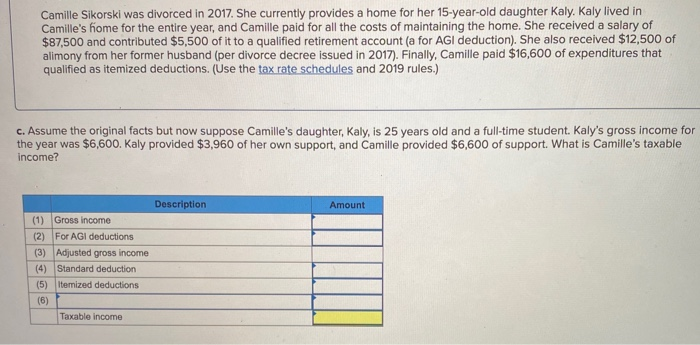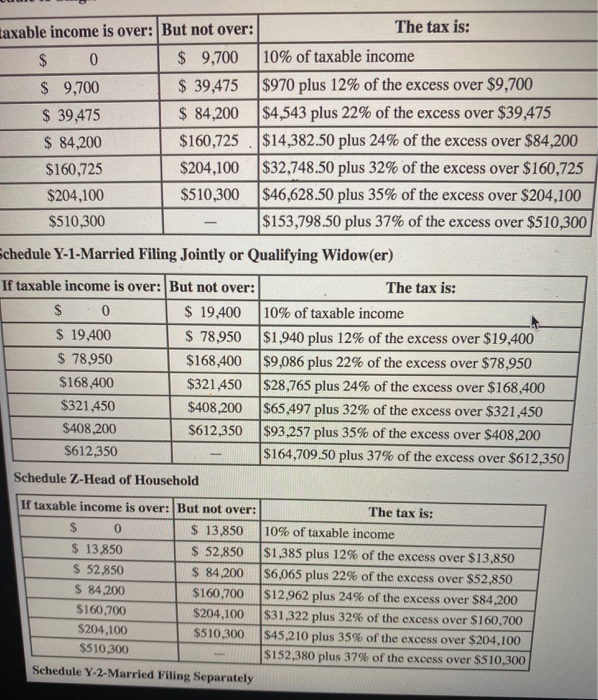Camille Sikorski was divorced in 2017. She currently provides a home for her 15-year-old daughter Kaly, Kaly lived in Camille's home for the entire year, and Camille paid for all the costs of maintaining the home. She received a salary of $87,500 and contributed $5,500 of it to a qualified retirement account (a for AGI deduction). She also received $12,500 of alimony from her former husband (per divorce decree issued in 2017). Finally, Camille paid $16,600 of expenditures that qualified as itemized deductions. (Use the tax rate schedules and 2019 rules.) a. What is Camille's taxable income? Amount 0 Description (1) Gross income (2) For AGI deductions (3) Adjusted gross income (4) Standard deduction (5) Itemized deductions (6) Taxable income Camille Sikorski was divorced in 2017. She currently provides a home for her 15-year-old daughter Kaly. Kaly lived in Camille's home for the entire year, and Camille paid for all the costs of maintaining the home. She received a salary of $87,500 and contributed $5,500 of it to a qualified retirement account (a for AGI deduction). She also received $12,500 of alimony from her former husband (per divorce decree issued in 2017). Finally, Camille paid $16,600 of expenditures that qualified as itemized deductions. (Use the tax rate schedules and 2019 rules.) b. What would Camille's taxable income be if she incurred $11,750 of itemized deductions instead of $16,600? Amount $ 0 Description (1) Gross income (2) For AGI deductions (3) Adjusted gross income (4) Standard deduction (5) Itemized deductions (6) Taxable income Camille Sikorski was divorced in 2017. She currently provides a home for her 15-year-old daughter Kaly. Kaly lived in Camille's home for the entire year, and Camille paid for all the costs of maintaining the home. She received a salary of $87,500 and contributed $5,500 of it to a qualified retirement account (a for AGI deduction). She also received $12,500 of alimony from her former husband (per divorce decree issued in 2017). Finally, Camille paid $16,600 of expenditures that qualified as itemized deductions. (Use the tax rate schedules and 2019 rules.) c. Assume the original facts but now suppose Camille's daughter, Kaly, is 25 years old and a full-time student. Kaly's gross income for the year was $6,600. Kaly provided $3,960 of her own support, and Camille provided $6,600 of support. What is Camille's taxable income? Description Amount (1) Gross income (2) For AGI deductions (3) Adjusted gross income (4) Standard deduction (5) Itemized deductions (6) Taxable income taxable income is over: But not over: The tax is: $ 0 $ 9,700 10% of taxable income $ 9,700 $ 39,475 $970 plus 12% of the excess over $9,700 $ 39,475 $ 84,200 $4,543 plus 22% of the excess over $39,475 $ 84,200 $160,725 $14,382.50 plus 24% of the excess over $84,200 $160,725 $204,100 $32,748.50 plus 32% of the excess over $160,725 $204,100 $510,300 $46,628.50 plus 35% of the excess over $204,100 $510,300 $153,798.50 plus 37% of the excess over $510,300 Schedule Y-1-Married Filing Jointly or Qualifying Widow(er) If taxable income is over: But not over: $ 0 $ 19,400 $ 19,400 $ 78,950 $ 78,950 $168,400 $168,400 $321,450 $321,450 $408.200 $408,200 $612,350 $612,350 The tax is: 10% of taxable income $1,940 plus 12% of the excess over $19,400 $9,086 plus 22% of the excess over $78,950 $28,765 plus 24% of the excess over $168,400 $65,497 plus 32% of the excess over $321,450 $93,257 plus 35% of the excess over $408,200 $164,709.50 plus 37% of the excess over $612,350 Schedule Z-Head of Household If taxable income is over: But not over: $ 0 $ 13,850 $ 13,850 $ 52,850 $ 52,850 $ 84,200 $ 84 200 $160,700 $160,700 $204,100 $204,100 $510,300 $510,300 The tax is: 10% of taxable income $1,385 plus 12% of the excess over $13,850 $6,065 plus 22% of the excess over $52,850 $12.962 plus 24% of the excess over $84,200 $31,322 plus 32% of the excess over $160,700 $45,210 plus 35% of the excess over $204,100 $152,380 plus 37% of the excess over $510,300 Schedule Y-2-Married Filing Separately hedule Z-Head of Household The tax is: f taxable income is over: But not over: $ 0 $ 13,850 $ 13,850 $ 52,850 $ 52,850 $ 84,200 $ 84,200 $160,700 $160,700 $204,100 $204,100 $510,300 $510,300 10% of taxable income $1,385 plus 12% of the excess over $13,850 $6,065 plus 22% of the excess over $52,850 $12,962 plus 24% of the excess over $84,200 $31,322 plus 32% of the excess over $160,700 $45,210 plus 35% of the excess over $204,100 $152,380 plus 37% of the excess over $510,300 Schedule Y-2-Married Filing Separately The tax is: If taxable income is over: But not over: $ 0 $ 9,700 $ 9,700 $ 39,475 $ 39475 $ 84,200 $ 84200 $160,725 $160,725 $204,100 $204,100 $306,175 $306,175 10% of taxable income $970 plus 12% of the excess over $9,700 $4,543 plus 22% of the excess over $39,475 $14,382.50 plus 24% of the excess over $84,200 $32,748.50 plus 32% of the excess over $160,725 $46,628.50 plus 35% of the excess over $204,100 $82,354.75 plus 37% of the excess over $306,175











